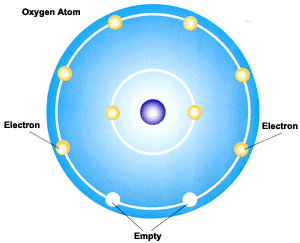oxygen

Oxygen atom.
Oxygen (O) is a colorless, odorless, gaseous element, the most abundant in Earth's crust (49.2% by mass) and the second most abundant in the atmosphere (28% by volume). Free oxygen is essential to the survival of all aerobic organisms.
Oxygen was discovered by Joseph Priestley in Leeds in 1774, and independently, and perhaps a year earlier, by Carl Scheele in Uppsala, Sweden. It was named by Antoine Lavoisier from the Greek oxy genes meaning "acid forming".
Chemistry of oxygen
Oxygen lies in group VIA of the periodic table. It is slightly soluble in water and reacts with most elements to form oxides. See also oxidation.
| atomic number | 8 |
| relative atomic mass | 15.9994 |
| electron configuration | 1s22s22p4 |
| atomic radius | 66 pm |
| oxidation state | -2 |
| density | 1.429 g/dm3 |
| melting point | -218.4ºC |
| boiling point | -183.0 ºC |
Allotropes of oxygen
The common allotrope of oxygen is the diatomic form known as dioxygen or, simply, oxygen (O2). There is also a reactive allotrope called ozone (O3).
Isotopes of oxygen
Oxygen has three stable isotopes: 16O (99.757%), 17O (0.038%), and 18O (0.205%). Variations in the 18O/16O and 17O/16O ratios (for example, in meteorites) are reported in terms of their deviations (δ18O and δ17O) in parts per thousand from a standard. The usual reference is standard mean ocean water (SMOW).
Industrial production and laboratory preparation of oxygen
Oxygen is extracted industrially by the fractional distillation of liquid air. It can also be obtained by the electrolysis of water.
One way to prepare oxygen in the lab is to heat potassium chlorate crystals (KClO2) with which black manganese dioxide powder has been mixed. The potassium dichlorate decomposes – oxygen is set free and potassium chloride (KCl) is left behind in the test tube. The manganese dioxide acts as a catalyst, reducing the temperature at which the potassium chlorate decomposes.
Uses of oxygen
Oxygen is used in steelmaking (by the Bessemer process), welding, the manufacture of industrial chemicals, and in apparatus for breathing (oxygen masks) and resuscitation (oxygen tents).
Liquid oxygen
Liquid oxygen is used as the oxidizer in many liquid-propellant rocket engines. Oxygen gas turns to liquid under standard atmospheric pressure at –183°C. Molecular weight: 32; density: 1.141 g/ml. Commonly referred to in rocketry as LOX.
Aerobic and anaerobic processes
Aerobic means requiring or connected with the presence of free oxygen. Aerobic respiration, also called aerobic metabolism or cell respiration, depends on the presence of oxygen for breaking down glucose and other foods to release energy. An anaerobic process, by contrast, is one that takes place in the absence of free oxygen.
Oxygen on Earth
After the Earth formed, about 4.5 billion years ago, it was continuously struck by comets and asteroids for hundreds of millions of years. After this incessant rain of impacting objects stopped, life appears to have established itself comparatively quickly, perhaps within 10 to 100 million year. As soon as life began on Earth, it started to disturb the atmosphere's chemical equilibrium. Oxygen built up slowly in the atmosphere over the next three billion years because it was a waste product expelled by some single-celled organisms. Then, around 600 million years ago, multicellular creatures developed and the oxygen content of the atmosphere rose suddenly. This trend was assisted by plants, which established themselves on the continents around 450 million years ago. Concurrently, evolution produced animals that breathed oxygen, instead of excreting it as a waste product. Without life, the oxygen content of the atmosphere would have sunk to extremely low levels.
Oxygen in the universe
Oxygen is the most abundant heavy element in the universe, and the third most abundant element overall, after hydrogen and helium. It is produced by massive stars – those born with a mass of over 8 solar masses – which eject the element into interstellar space when they explode. Oxygen burning is the fusion of oxygen into the even heavier elements silicon and sulfur.


